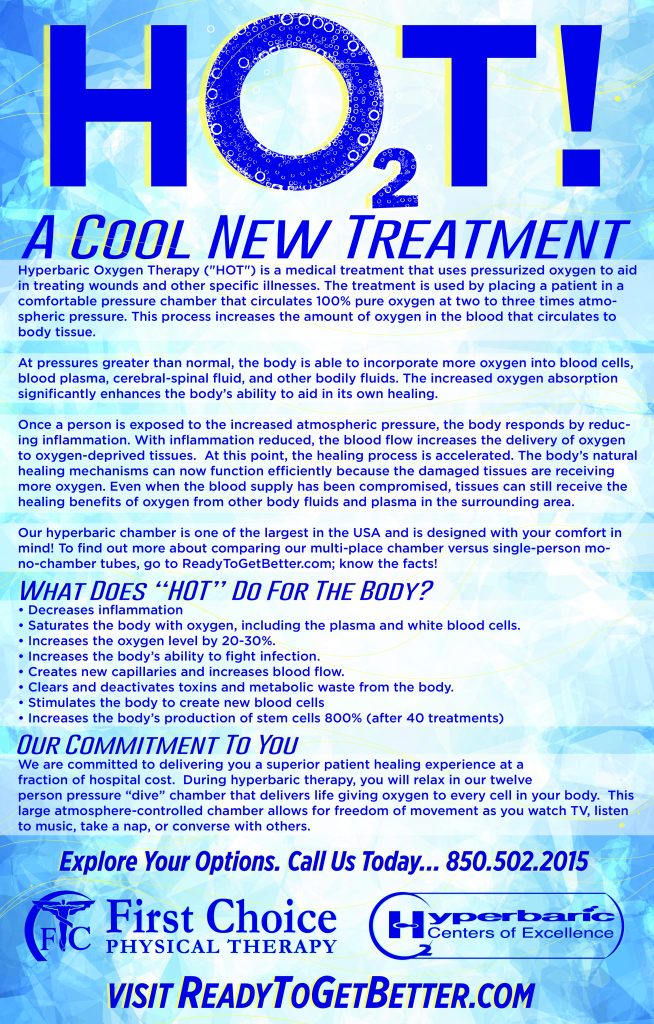Kathie F

I really feel like the PTs here care about getting me back to my healthiest self post-injury/surgery.
Thank you Kathie! That is exactly our goal for our patients. Merry Christmas.
A Cool New Treatment!
Want to research Hyperbaric Oxygen Therapy even more? Check out our library of documents here.
Study Shows New Israeli Treatment For Fibromyalgia
Do you suffer from fibromyalgia? Take a look at this new study from Israel of a hyperbaric treatment for fibromyalgia patients. This hyperbaric medicine showed an improvement in 100% of sufferers. Hyperbaric Centers of Excellence located in Panama City Beach, Fl may be the answer for you!
http://fibromyalgianewstoday.com/2015/06/09/hyperbaric-therapy-offers-hope-fibromyalgia-sufferers/
Swimmer’s Shoulder

Brannon Chester, DPT
Doctor of Physical Therapy
Jamie McDonald
NCAA Swimmer, University of West Florida
It’s just a little tendonitis…Right?

Reactive tendinopathy is the early stage of tendon dysfunction and is a short-term adaptive thickening in attempt to reduce the stress placed upon the tendon. In this stage, the tendon can revert back to normal structure if overload is reduced or sufficient time is given between loading. Tendon dysrepair, there is greater matrix (tissue composition) breakdown of the tendon. We see this in all ages of patients and activity levels. In this stage, the tendon appears thickened with more localized changes. Degenerative tendinopathy is the last and most dangerous stage of tendon dysfunction. There is greater matrix and cell breakdown, with even some areas of cell death in this particular stage. If gone unchecked, this stage can inevitably lead to rupture.
Due to the fact that tendonitis/tendinopathy is an overuse injury, the best course of action is to decrease the stress and overloading of the tendon. In other words, REST. Also, through specific treatment interventions including soft tissue mobilization, eccentric strengthening, and evaluating the ultimate cause of the tendon dysfunction, we can prevent any further damage done to the tendon. If you are experiencing any sort of joint pain or “tendonitis” pain, come in and see one of our Doctors of Physical Therapy for a thorough evaluation to determine the best course of treatment for your particular injury.
Brannon Chester, DPT
Doctor of Physical Therapy
Tennis elbow anyone?

The importance of running shoes…
Published June 17, 2015 |

Simon Haussmann, PTA
“What A Pain in The Neck”

Brannon Chester, DPT
Doctor of Physical Therapy
Balance Lost?

Scott Champagne, PT.
Stay on the Baseball field and out of the operating room…

Complaints of shoulder and elbow pain are the most common reasons why a baseball athlete seeks medical attention. According to Dr. James Andrews, “Most injuries are a consequence of cumulative micro-trauma from the repetitive, dynamic overhand throwing motion inherent to the sport.” In other words, the constant repetitive demands put on the shoulder from throwing a baseball without the proper strength, mechanics, and rest are the major cause for injury in a baseball player.
Overthrowing and over utilizing the young athlete has become a huge problem in youth baseball today. Doctors have found a link between throwing volume and shoulder/elbow injuries among youth baseball pitchers and these findings have prompted the USA Baseball Medical and Safety Advisory Committee to recommend pitch limits for youth pitchers. According to the USA Baseball Medical team, not only monitoring pitch counts but having pitchers (1) compete NO MORE than 9 months in a calendar year, (2) develop and maintain good mechanics, (3) commit to year-round physical conditioning as their bodies develop, (4) participate in only 1 performance as a pitcher per day, (5) avoid showcase participation, and (6) limit participation to 1 team per season.
Rehabilitation plays a vital part for the athlete, in not only returning to sport, but injury prevention as well as pre-season training to prepare the body for the demands of their respective sport. Traditional rehabilitation is not sufficient and cannot reproduce the speed or the joint forces generated during throwing. According to Journal of Sport Rehabilitation, “The only way to mimic the forces of a baseball throw is to actually throw a ball. Interval throwing programs are progressive, sport specific regimens that gradually expose an athlete to the demands they will experience upon a return to sport.” If not properly prepared, an athlete is vulnerable to injury upon return to sports participation. This is true whether the athlete has a throwing-arm injury, a non-throwing-arm injury, or an injury to any region of the body that has resulted in lost playing time.
As the spring season wraps up, and the summer baseball season begins, make sure your athlete is prepared for the stresses associated with throwing. If you have had any shoulder/elbow pain from throwing come by First Choice Physical Therapy for an in depth evaluation which includes shoulder mechanics, strength deficits, and an interval throwing program instruction.
Brannon Chester, DPT
Doctor of Physical Therapy
Is there a fall in your future?

Scott Champagne, PT
Heel Pain!



